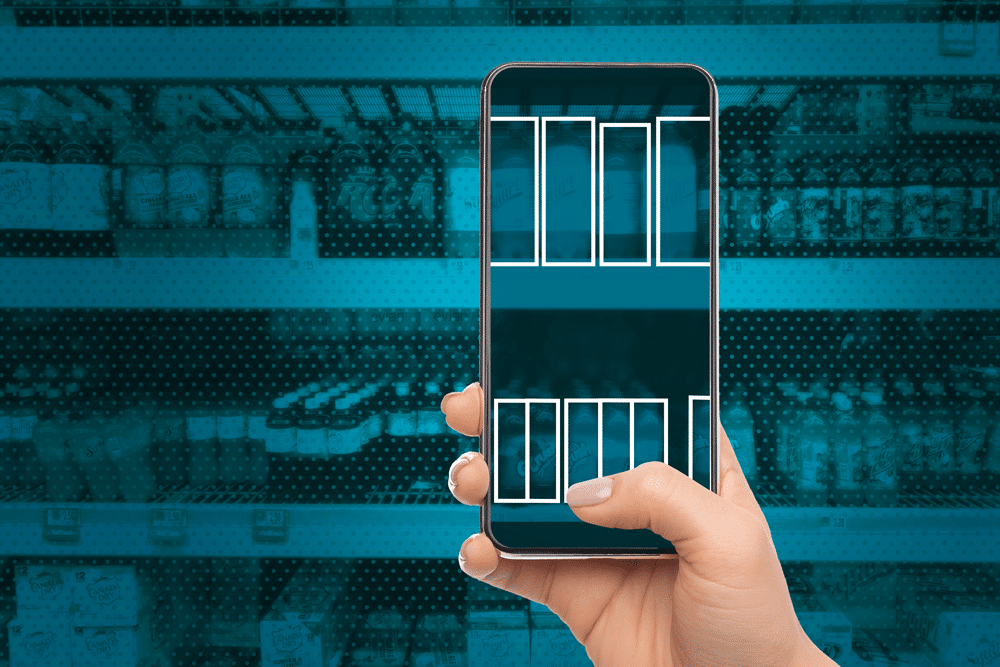The pandemic continues to shape the world as we once knew it. By now, we’re all more than familiar with “the new normal” that is our social, personal, and professional lives. Previously crowded gyms and office buildings were quickly vacated, and increased time at home allowed many to focus on what truly matters. And of course, most of the population flipped their daily routines upside down to limit contact with the outside world.
This time also brought major disruption to the world of commerce and retail. Most of what retailers knew about their consumers’ wants and needs no longer applied, as eCommerce expanded exponentially and no-contact pickups and deliveries became the preferred way to receive it all—from a new loungewear set to a week’s worth of household groceries.
Although the buying habits of consumers changed significantly over the pandemic, shoppers are quickly returning to in-store experiences, especially grocery stores, where Consumer Packaged Goods (CPG) brands gain and retain most of their customers.
As a result, CPG brands are evolving their retail execution plans to account for a laundry list of recent industry changes. They’re turning to image recognition—one of the most innovative and fastest-growing subsets of AI technology—to help them keep up with consumer expectations and market demands.
These shifts in retail experiences combined with fast-growing technology will result in image recognition playing a significant role in retail in 2022. It’s essential for CPG leaders to be aware of these trends and leverage them to gain valuable data, ensure backend selling strategies are executed correctly, and to ultimately get closer to their consumers.
What is Image Recognition Technology?
Image recognition technology is an AI-based tool used to identify objects, logos, people, and places within a digital image.
As organizations look to improve data analysis and automate cross-functional tasks, image recognition and similar AI technologies are growing in popularity and adoption in various applications. In fact, experts claim that the Image Recognition in Retail market will reach $3.7 billion by 2025.
Retail image recognition technology helps on-site brand representatives audit products in the field quickly and effectively, then share their insights with stakeholders and other offsite team members. It leverages AI algorithms to detect specific products within each photo and collect analytics data related to:
- Branding and packaging
- Shelf placement
- Competitor products
- Pricing and promotional signage
- In-stock conditions
- Planogram & trade compliance
The Role of Image Recognition Software in Retail Execution
In the fast-paced world of CPG, onsite brand representatives are essential to leadership teams. They visit multiple retail locations to assess how well merchandising and sales strategies are executed to ensure brand consistency and excellence across locations.
To stay competitive, CPG brands need a clear understanding of exactly how their products are stocked, displayed, and positioned to their consumers. Leadership teams want to understand how easily consumers discover their products at the store and how often their products go out of stock.
Unfortunately, executives can’t visit every store location or evaluate each of their products individually. This lack of in-store visibility often means a significant delay in resolving execution errors — resulting in lost sales and poor ROI on current promotions or similar selling initiatives.
At a high level, image recognition software can help brands answer questions like:
Does our product mix align with the current season and any promotional offers? Have we rolled out holiday items already?
Is our product priced appropriately compared to the competition? Are competitors offering a significant discount that creates a threat for our brand?
Are special promotional displays that were negotiated in place? Is the retailer using our agreed-on seasonal display and associated POP signage?
Not only does image recognition uncover details about all of the above elements, but it also streamlines tasks for on-site brand reps. Teams can wave goodbye to pen-and-paper auditing and automate data capture without the risk of missing out on critical information.
Amidst the “Great Resignation” and all-encompassing labor shortage across the globe, AI-based software enables brands to improve efficiency and effectiveness without adding headcount or restricting valuable team members to tedious manual tasks.
Image recognition helps brands evaluate various execution elements at scale and go beyond standard audits and reviews to capture trends that reps might miss while they’re on site. The insights derived from image recognition software help organizations:
- Accurately identify and replace out-of-stock products
- Ensure planogram compliance
- Understand regional product sales and purchasing trends
- Provide retailers with informed product recommendations
- Learn more about their consumers’ experiences
By giving teams the ability to capture next-level details with mobile task management workflows, brand leaders can react to concerns quickly and direct their teams to take the next best steps.
A fast-paced resolution might mean offering a discount to a particular retailer, restocking high-demand SKUs, or negotiating for more display space at specific stores. This same-day reactivity helps CPG brands protect sales and keep consumers happy.
By giving teams the ability to capture next-level details with mobile task management workflows, brand leaders can react to concerns quickly and direct their teams to take the next best steps.
A fast-paced resolution might mean offering a discount to a particular retailer, restocking high-demand SKUs, or negotiating for more display space at specific stores. This same-day reactivity helps CPG brands protect sales and keep consumers happy.
Top CPG Image Recognition Trends for 2022
In 2022, image recognition will continue to help CPG brands drive sales, improve their shelf share, and boost product visibility in retail stores through a range of complementary capabilities.
TREND #1: PRODUCT RECOGNITION SOFTWARE
Product and brand recognition are essential parts of the CPG sales cycle, especially since 59% of consumers prefer to buy from a brand they trust, even if they’re shopping for a new product.
To evaluate execution in stores, CPG sellers take photos of their products on the shelf to assess appearance, placement, and proximity to competitor offerings.
They analyze each image in detail to determine which SKUs appear where, how they’re arranged on the shelf, and the visibility of recognizable branding elements — like logos or primary brand colors.
With image recognition technology, teams can eliminate manual image review and organization, empowering them to evaluate product performance more efficiently and accurately than ever before.
Image recognition software leverages automated workflows to organize photo libraries by SKU-level details product name, size, price, etc. Then, teams can use it to view, filter, and sort photos to study trends, assess product presentation, and more.
Image Recognition by FORM offers a mobile image recognition solution powered by AI. With capabilities like grid capture and even menu recognition, our image recognition app helps deliver valuable market insights and real-time opportunities to reps—all in the palm of their hand. See it in action here.
TREND #2: RETAIL DATA CAPTURE
Shoppers make 82% of their purchasing decisions in-store, and 80% of them are actively looking for deals when shopping, which means brands need to stand out from the crowd to attract new customers and boost their sales.
Beyond brand and product recognition, sellers want to understand how shoppers perceive and interact with their products while in the store.
Retail data capture enables teams to extract next-level competitive intelligence from image recognition data and use it to inform future sales strategies or make real-time adjustments to how, when, and where they present their products to shoppers.
Some mobile apps even allow on-site reps to take photos in a single, smooth snap, like Image Recognition by FORM. Grid Capture allows for faster, more accurate photos of execution by automatically stitching each one together to show a full view of the shelf or display. Try it out for yourself.
Retail data capture uncovers a myriad of insights — from improper shelf placement to missing promotional signage or competitor placement that violates a brand’s retailer agreement.
TREND #3: INVENTORY ANALYSIS
Today’s retail consumers often prioritize product availability over variety. And when they encounter out-of-stock scenarios at the store, they’re three times as likely to pick the same product of a competitor brand than they are to wait for their first choice to get restocked, which means lost sales and potential loss of a long-time brand loyalist.
In fact, retailers have missed out on nearly $1 trillion in sales due to their products being out of stock, which means CPG firms need to ensure they’re keeping the correct products on grocery store shelves at all times.
Image recognition is essential in this effort as AI technology delivers quick, highly accurate inventory analysis. The software studies digital images to identify out-of-stock products in minutes, so onsite representatives can replenish missing SKUs through a supplier or by following up directly with the retailer to discuss why backstock hasn’t made it out onto the floor.
Beyond same-day resolution, inventory analysis helps CPG brands monitor recurring inventory trends to better understand consumer buying habits, product popularity, and whether their retail partners restock shelves in accordance with contractual agreements.
Adopting Image Recognition for Retail Execution
In retail, image recognition software helps CPG brands make data-driven evaluations of both their products and their retail partners. It also increases frontline efficiency and improves in-store execution so brands can deliver better customer experiences in 2022 and beyond.
To successfully execute and evaluate their in-store strategies, CPG leaders need a proven, user-friendly image recognition software platform that’s easy for teams to learn and use on the go.
FORM’s mobile app helps brands leverage AI in retail and CPG, with the world’s only integrated task management and image recognition software. It provides product recognition and retail data capture capabilities into a single solution.
Our user-friendly, on-the-go image recognition technology helps brand reps audit and analyze in-store displays in a snap, then follow up appropriately to keep their customers happy and protect their bottom line. It also gives leadership teams unparalleled visibility into in-store execution and customers’ purchasing habits so they can make informed decisions about future merchandising initiatives.
Want to see our solution in action? Request a demo of GoSpotCheck by FORM today.




